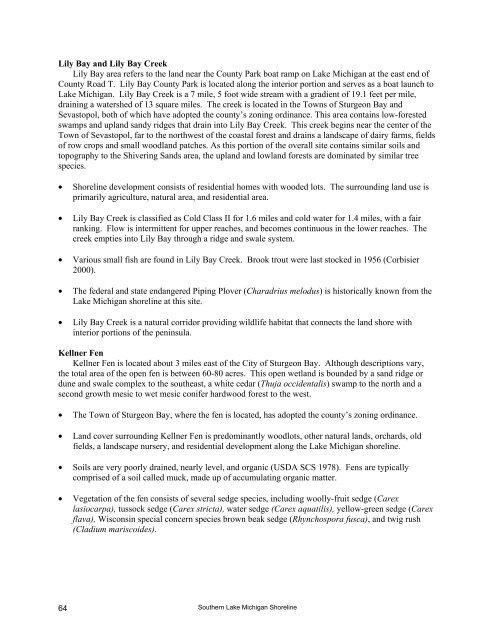Guide to Significant Wildlife Habitat - Door County Web Map
Guide to Significant Wildlife Habitat - Door County Web Map
Guide to Significant Wildlife Habitat - Door County Web Map
You also want an ePaper? Increase the reach of your titles
YUMPU automatically turns print PDFs into web optimized ePapers that Google loves.
Lily Bay and Lily Bay Creek<br />
Lily Bay area refers <strong>to</strong> the land near the <strong>County</strong> Park boat ramp on Lake Michigan at the east end of<br />
<strong>County</strong> Road T. Lily Bay <strong>County</strong> Park is located along the interior portion and serves as a boat launch <strong>to</strong><br />
Lake Michigan. Lily Bay Creek is a 7 mile, 5 foot wide stream with a gradient of 19.1 feet per mile,<br />
draining a watershed of 13 square miles. The creek is located in the Towns of Sturgeon Bay and<br />
Sevas<strong>to</strong>pol, both of which have adopted the county’s zoning ordinance. This area contains low-forested<br />
swamps and upland sandy ridges that drain in<strong>to</strong> Lily Bay Creek. This creek begins near the center of the<br />
Town of Sevas<strong>to</strong>pol, far <strong>to</strong> the northwest of the coastal forest and drains a landscape of dairy farms, fields<br />
of row crops and small woodland patches. As this portion of the overall site contains similar soils and<br />
<strong>to</strong>pography <strong>to</strong> the Shivering Sands area, the upland and lowland forests are dominated by similar tree<br />
species.<br />
• Shoreline development consists of residential homes with wooded lots. The surrounding land use is<br />
primarily agriculture, natural area, and residential area.<br />
• Lily Bay Creek is classified as Cold Class II for 1.6 miles and cold water for 1.4 miles, with a fair<br />
ranking. Flow is intermittent for upper reaches, and becomes continuous in the lower reaches. The<br />
creek empties in<strong>to</strong> Lily Bay through a ridge and swale system.<br />
• Various small fish are found in Lily Bay Creek. Brook trout were last s<strong>to</strong>cked in 1956 (Corbisier<br />
2000).<br />
• The federal and state endangered Piping Plover (Charadrius melodus) is his<strong>to</strong>rically known from the<br />
Lake Michigan shoreline at this site.<br />
• Lily Bay Creek is a natural corridor providing wildlife habitat that connects the land shore with<br />
interior portions of the peninsula.<br />
Kellner Fen<br />
Kellner Fen is located about 3 miles east of the City of Sturgeon Bay. Although descriptions vary,<br />
the <strong>to</strong>tal area of the open fen is between 60-80 acres. This open wetland is bounded by a sand ridge or<br />
dune and swale complex <strong>to</strong> the southeast, a white cedar (Thuja occidentalis) swamp <strong>to</strong> the north and a<br />
second growth mesic <strong>to</strong> wet mesic conifer hardwood forest <strong>to</strong> the west.<br />
• The Town of Sturgeon Bay, where the fen is located, has adopted the county’s zoning ordinance.<br />
• Land cover surrounding Kellner Fen is predominantly woodlots, other natural lands, orchards, old<br />
fields, a landscape nursery, and residential development along the Lake Michigan shoreline.<br />
• Soils are very poorly drained, nearly level, and organic (USDA SCS 1978). Fens are typically<br />
comprised of a soil called muck, made up of accumulating organic matter.<br />
• Vegetation of the fen consists of several sedge species, including woolly-fruit sedge (Carex<br />
lasiocarpa), tussock sedge (Carex stricta), water sedge (Carex aquatilis), yellow-green sedge (Carex<br />
flava), Wisconsin special concern species brown beak sedge (Rhynchospora fusca), and twig rush<br />
(Cladium mariscoides).<br />
64<br />
Southern Lake Michigan Shoreline




![A Guide to the Control and Management of Invasive Phragmites [PDF]](https://img.yumpu.com/19126786/1/190x190/a-guide-to-the-control-and-management-of-invasive-phragmites-pdf.jpg?quality=85)







![Homeowner's Guide to Japanese Knotweed Control [PDF]](https://img.yumpu.com/19126766/1/190x245/homeowners-guide-to-japanese-knotweed-control-pdf.jpg?quality=85)




